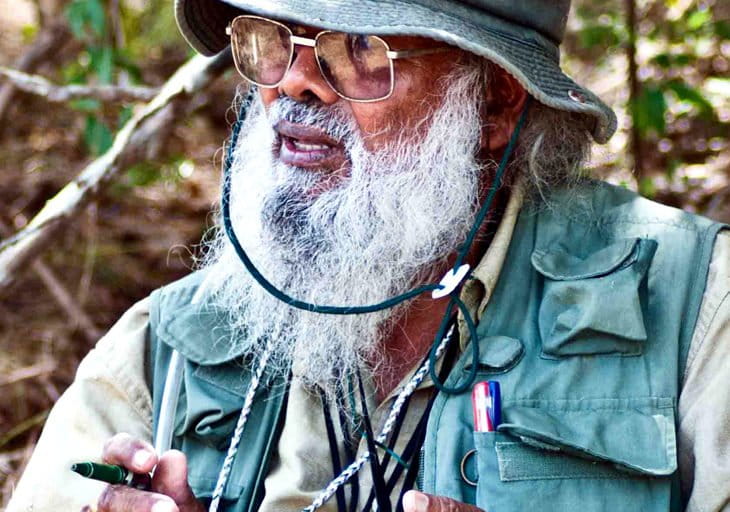- Researchers in Sri Lanka have described a new species of day gecko, known only from a single reptile-rich habitat of the island’s Central Massif region, bringing to 33 the number of species in the genus found in Sri Lanka.
- They’ve named the gecko Cnemaspis anslemi, in honor of herpetologist Anslem de Silva, whom they describe as the father of modern herpetology in Sri Lanka.
- The diminutive, range-restricted gecko dwells in both home gardens and tropical evergreen rainforests in the Udamaliboda area, but its habitat is threatened by expanding tea and rubber plantations and mini hydropower plants.
- De Silva, who has a prolific record of his own in describing new species, says the latest discovery underscores the unique ways that reptiles and amphibians have evolved in the varied ecosystems in Sri Lanka, and means that more discoveries await.
COLOMBO — For nearly five decades he’s helped introduce stunning new species of reptiles and amphibians found only in Sri Lanka to the rest of the world. He’s also inspired a new generation of scientists eager to showcase and conserve their country’s natural wealth. Now, legendary herpetologist Anslem de Silva — “the father of modern herpetology in Sri Lanka” — is being honored with a new species of gecko named after him.
Cnemaspis anslemi is a diminutive species of day gecko, a genus that’s typically active in the daytime, found only in the lush green canopied region of Udamaliboda, in the northwestern foothills of Samanalawewa Nature Reserve.
The new species is described in a paper in the journal Amphibian & Reptile Conservation, and brings the number of Cnemaspis geckos in Sri Lanka to 33 — all of them found only on the island. In fact, Sri Lanka is home to a fifth of all known Cnemaspis species worldwide.
Lead researcher Sameera Suranjan Karunarathna told Mongabay that it was a privilege to name the new gecko after de Silva, who he said had contributed immensely in shining a light on Sri Lanka’s rich biodiversity and inspired a new generation of herpetologists including himself and co-author Kanishka Ukuwela.
“There is so much to celebrate in him [de Silva] and we felt as the country felicitated him at a recent event, naming this species, discovered not too far from his own home, in his honor would be just right. It is our way to pay tribute to a pathfinder,” Karunarathna said.

Habitat under threat
The new species’ sole known habitat comprises both tropical evergreen rainforests and home gardens. The area is interspersed with tea and rubber plantations, and features a hiking trail leading to a popular Buddhist pilgrimage site on Adam’s Peak, a mountain with a rock formation said to be the footprint of the Buddha.
Eleven species of geckos occur in the Udamaliboda trail area, out of the 65 total reptile species recorded there. That makes the locality a hotspot of reptile diversity.
But it’s also an area under threat from human activity, Karunarathna said, mostly in the form of unplanned development and expanding farms.
“Their habitat is disturbed by encroachment, largely with the expanding tea and rubber plantations, as well as the mini hydropower projects,” he said. “It is necessary that authorities consider it unsuitable to build mini hydropower plants within such unique natural habitats causing immense damage to ecosystems.”
He warned that if such encroachments continued, it would mean the loss of an entire habitat for a species adapted to survive nowhere else. For this reason, Karunarathna and Ukuwela have proposed that C. anslemi be considered critically endangered under the IUCN Red List criteria.
The researchers have called for urgent conservation of these forest foothills, home to a multitude of species and forming a part of a globally significant biodiversity hotspot.
“It calls also for hands-on conservation management practices,” Karunarathna said.

‘Unfathomed biodiversity’
Sri Lanka is home to 54 gecko species belonging to eight genera, demonstrating remarkable biodiversity and accounting for 24 percent of the island’s reptile species. Of these 54 species, 45 are considered threatened, and 44 are found nowhere else on Earth.
De Silva said the high level of diversity demonstrated that the various pockets of ecosystems around Sri Lanka were fertile habitats for species to evolve in entirely unique ways from one another. That, he said, means more discoveries lie in wait.
“The multiple discoveries of Cnemaspis species in recent years indicate not just high levels of endemism but also unfathomed levels of biodiversity,” he said. “These diminutive day geckos tell us a unique story of evolutionary biology as well. Clearly, the recent discoveries have contributed significantly to the advancement of knowledge of Cnemapsis species, but the level of discoveries show how much is still to be discovered.”
Citation:
Karunarathna, S. S., & Ukuwela, K. D. (2019). A new species of dwarf day gecko (Reptilia: Gekkonidae: Cnemaspis) from lower-elevations of Samanala Nature Reserve in Central massif, Sri Lanka. Amphibian & Reptile Conservation, 13(2), 14-27.
Banner image of a male Cnemaspis anslemi, a newly described day gecko named after Sri Lankan herpetologist Anslem de Silva, courtesy of Sameera Suranjan Karunarathna.
